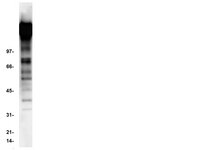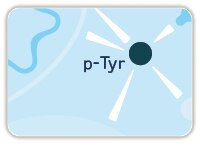Cross-linking of IgGs bound on circulating neutrophils leads to an activation of endothelial cells: possible role of rheumatoid factors in rheumatoid arthritis-associated vascular dysfunction.
Rollet-Labelle, E; Vaillancourt, M; Marois, L; Newkirk, MM; Poubelle, PE; Naccache, PH
Journal of inflammation (London, England)
10
27
2013
Show Abstract
Rheumatoid arthritis is characterized by the presence of circulating auto-antibodies, including rheumatoid factors, which recognize the Fc portion of IgGs. The neutrophil is the most abundant circulating leukocyte and it expresses high levels of FcγRs on its surface. The aim of the present study was to examine the capacity of circulating human neutrophils to be activated by rheumatoid factors and the consequences of these events on endothelium.Neutrophil-bound IgGs were cross-linked with anti-human IgGs to mimick the presence of circulating rheumatoid factors and FcγRs-dependent signalling events and functions were examined. The IgG and IgM composition of rheumatoid factors isolated from the serum of RA patients was characterized. Adhesion of neutrophils to endothelial cells was quantified in response to the addition of rheumatoid factors.Cross-linking of IgGs bound on neutrophils leads to FcγRs-dependent tyrosine phosphorylation, mobilisation of intracellular calcium and the extracellular release of superoxide anions and lysozyme. Incubation of endothelial cells with the supernatant of activated neutrophils increases ICAM-1 expression and IL-8 production by endothelial cells. Finally, rheumatoid factors enhance neutrophil adhesion to endothelial cells.Our results show that activation of neutrophils' FcγRs by rheumatoid factors could participate in rheumatoid arthritis-associated vascular damage. | | 23902799
 |
ALK-activating homologous mutations in LTK induce cellular transformation.
Roll, JD; Reuther, GW
PloS one
7
e31733
2012
Show Abstract
Leukocyte tyrosine kinase (LTK) is a receptor tyrosine kinase reported to be overexpressed in human leukemia. Though much regarding the function of LTK remains unknown, it shares a high degree of similarity with anaplastic lymphoma kinase (ALK), which is found mutated in human cancer. In order to determine if LTK has transforming potential, we created two LTK mutants, F568L and R669Q, that correspond to two well-characterized activating mutations of ALK (F1174L and R1275Q). LTK-F568L, but not wildtype LTK or LTK-R669Q, transformed hematopoietic cells to cytokine independence. LTK-F568L exhibited a stronger ability to induce loss of contact inhibition and anchorage-independent growth of epithelial cells compared to LTK-R669Q, while wildtype LTK was non-transforming in the same cells. Likewise, LTK-F568L induced greater neurite outgrowth of PC12 cells than R669Q, while wildtype LTK could not. Correlating with transforming activity, LTK-F568L displayed significantly enhanced tyrosine phosphorylation compared to wildtype LTK and LTK-R668Q and induced activation of various signaling proteins including Shc, ERK and the JAK/STAT pathway. Expression of wildtype LTK or LTK-R669Q generally led to weaker activation of signaling proteins than expression of LTK-F568L, or no activation at all. Thus, mutating LTK at residue F568, and to a lesser extent at R669, activates the receptor tyrosine kinase, inducing cell signaling that results in transforming properties. These studies suggest that aberrant activation of LTK may contribute to neoplastic cell growth. | | 22347506
 |
Centrosomal targeting of tyrosine kinase activity does not enhance oncogenicity in chronic myeloproliferative disorders.
T Bochtler,M Kirsch,B Maier,J Bachmann,U Klingmüller,S Anderhub,A D Ho,A Krämer
Leukemia : official journal of the Leukemia Society of America, Leukemia Research Fund, U.K
26
2012
Show Abstract
Constitutive tyrosine kinase activation by reciprocal chromosomal translocation is a common pathogenetic mechanism in chronic myeloproliferative disorders. Since centrosomal proteins have been recurrently identified as translocation partners of tyrosine kinases FGFR1, JAK2, PDGFRα and PDGFRβ in these diseases, a role for the centrosome in oncogenic transformation has been hypothesized. In this study, we addressed the functional role of centrosomally targeted tyrosine kinase activity. First, centrosomal localization was not routinely found for all chimeric fusion proteins tested. Second, targeting of tyrosine kinases to the centrosome by creating artificial chimeric fusion kinases with the centrosomal targeting domain of AKAP450 failed to enhance the oncogenic transforming potential in both Ba/F3 and U2OS cells, although phospho-tyrosine-mediated signal transduction pathways were initiated at the centrosome. We conclude that the centrosomal localization of constitutively activated tyrosine kinases does not contribute to disease pathogenesis in chronic myeloproliferative disorders. | | 22015771
 |
Wnt/β-catenin dependent cell proliferation underlies segmented lateral line morphogenesis.
Aman, Andy, et al.
Dev. Biol., 349: 470-82 (2011)
349
2011
Show Abstract
Morphogenesis is a fascinating but complex and incompletely understood developmental process. The sensory lateral line system consists of only a few hundred cells and is experimentally accessible making it an excellent model system to interrogate the cellular and molecular mechanisms underlying segmental morphogenesis. The posterior lateral line primordium periodically deposits prosensory organs as it migrates to the tail tip. We demonstrate that periodic proneuromast deposition is governed by a fundamentally different developmental mechanism than the classical models of developmental periodicity represented by vertebrate somitogenesis and early Drosophila development. Our analysis demonstrates that proneuromast deposition is driven by periodic lengthening of the primordium and a stable Wnt/β-catenin activation domain in the leading region of the primordium. The periodic lengthening of the primordium is controlled by Wnt/β-catenin/Fgf-dependent proliferation. Once proneuromasts are displaced into the trailing Wnt/β-catenin-free zone they are deposited. We have previously shown that Wnt/β-catenin signaling induces Fgf signaling and that interactions between these two pathways regulate primordium migration and prosensory organ formation. Therefore, by coordinating migration, prosensory organ formation and proliferation, localized activation of Wnt/β-catenin signaling in the leading zone of the primordium plays a crucial role in orchestrating lateral line morphogenesis. | | 20974120
 |
An RNA interference screen identifies a novel regulator of target of rapamycin that mediates hypoxia suppression of translation in Drosophila S2 cells.
Lee, SJ; Feldman, R; O'Farrell, PH
Molecular biology of the cell
19
4051-61
2008
Show Abstract
In addition to its central role in energy production, oxygen has pervasive regulatory actions. Hypoxia (oxygen limitation) triggers the shutdown of major cellular processes, including gene expression. We carried out a genome-wide RNA interference (RNAi) screen in Drosophila S2 cells for functions required to down-regulate translation during hypoxia. RNAi knockdown of specific genes allowed induction of a green fluorescent protein (GFP) reporter gene and continued protein synthesis during hypoxia. Among the identified genes, Tsc1 and Tsc2, which together form the tuberose sclerosis complex that negatively regulates target of rapamycin (TOR) kinase, gave an especially strong effect. This finding is consistent with the involvement of TOR in promoting translation. Another gene required for efficient inhibition of protein translation during hypoxia, the protein tyrosine phosphatase 61F (Ptp61F), down-regulates TOR activity under hypoxia. Lack of Ptp61F or Tsc2 improves cell survival under prolonged hypoxia in a TOR-dependent manner. Our results identify Ptp61F as a novel modulator of TOR activity and suggest that its function during hypoxia contributes to the down-regulation of protein synthesis. Full Text Article | | 18653470
 |
Polo kinase links the stress pathway to cell cycle control and tip growth in fission yeast.
Janni Petersen, Iain M Hagan
Nature
435
507-12
2005
Show Abstract
Stress-activated mitogen-activated protein kinase cascades instigate a range of changes to enable eukaryotic cells to cope with particular insults. In Schizosaccharomyces pombe these responses include the transcription of specific gene sets and inhibition of entry into mitosis. The S. pombe stress response pathway (SRP) also promotes commitment to mitosis in unperturbed cell cycles to allow cells to match their rate of division with nutrient availability. The nature of this SRP function in cell cycle control is unknown. Entry into mitosis is controlled by mitosis-promoting factor (MPF; Cdc2/cyclin B) activity. Inhibitory phosphorylation of Cdc2 by Wee1 kinase inactivates MPF until Cdc25 removes this phosphate to promote mitosis. The balance between Wee1 and Cdc25 activities is influenced by the recruitment of polo kinase (Plo1) to the spindle pole body (SPB). The SPB component Cut12 mediates this recruitment. Hyper-activating mutations in either cut12 or plo1 enable Cdc25-defective cells to enter mitosis. The hyperactive cut12.s11 mutation suppresses cdc25.22, as it promotes recruitment of active Plo1 to interphase SPBs. Here we show that the SRP promotes phosphorylation of Plo1 on Ser 402. In unperturbed cell cycles, SRP-mediated phosphorylation of Ser 402 promotes Plo1 recruitment to SPBs and thus commitment to mitosis. Ser 402 phosphorylation also ensures efficient reinitiation of cell tip growth and cell division during recovery from particular stresses. Thus, phosphorylation of Plo1 Ser 402 not only enables SRP signalling to modulate the timing of mitotic commitment in response to nutrient status in unperturbed cycles, but also promotes the return to normal cell cycle control after stress. | | 15917811
 |

























